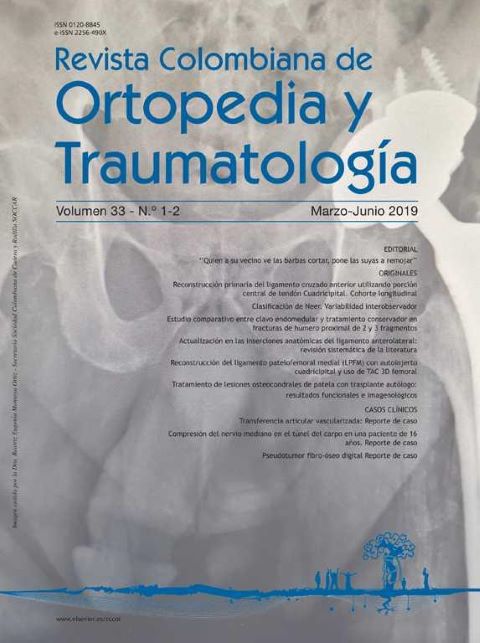Interobserver Variability Of Neer Classification
DOI:
https://doi.org/10.1016/j.rccot.2019.10.002Keywords:
proximal humerus fractures, Neer’s classification, interobserver variabilityAbstract
Background: To study inter-observer variability by evaluating a fracture of the proximal humerus using Neer’s classification and to establish its diagnostic and therapeutic utility.
Methods: A computerised form was used with 20 randomly selected cases of fractures ofthe proximal humerus, from the same hospital between 2010 and 2014. Each case included: age, gender, laterality, and two radiographic projections. They were anonymously evaluated by Traumatologists, for whom shoulder surgery was routine practice or not, from national and international hospitals. They indicated Neer stage and an appropriate therapeutic option. Interobserver variability was established between groups, and comparing all of them equally, calculating Fleap’s Kappa index and interpreting it according to the Landis and Koch criteria.
Results: A total of 40 responses were obtained from the Traumatologists, 15 of them were shoulder surgery was usual practice and 25 where it was not. The mean Fleap Kappa index was 0.173 in the Traumatologists group were shoulder surgery was usual practice, being 0.176 in the group were it was not usual practice. The overall index was 0.184. There is wide interobserver variability in the therapeutic indication, as well as within the surgical indication.
Discussion: The level of agreement obtained, according to the criteria of Landis and Koch, was poor in all groups in terms of stage, and weak in terms of treatment. The experience of the Traumatologist had no influence. A more reproducible classification may be necessary since Neer’s classification has sufficient interobserver variability to accept it as the sole means of decision making.
Evidence Level: III.
Downloads
References
Breasted J. The Edwin Smith Surgical Papyrus. Chicago, IL: University of Chicago Press; 1933. p. 596.
Jakob RP, Ganz R. Proximal humerus fractures. Helv Chir Acta. 1982;48:595-610.
Papakonstantinou MK, Hart MJ, Farrugia R, Gabbe BJ, Kamali Moaveni A, van Bavel D, Page RS, Richardson MD. Interobserver agreement of Neer and AO classifications for proximal humeral fractures. ANZ J Surg. 2016;86:280-4, 10.1111/ans.13451. Epub Feb 172016. https://doi.org/10.1111/ans.13451
Brorson S, Olsen BS, Frich LH, Jensen SL, Sørensen AK, Krogsgaard M, Hróbjartsson A. Surgeons agree more on treatmentrecommendations than on classification of proximal humeral fractures. BMC Musculoskelet Disord. 2012;13:114, https://doi.org/10.1186/1471-2474-13-114
Foroohar A, Tosti R, Richmond JM, Gaughan JP, Ilyas AM. Classification and treatment of proximal humerus fractures: inter-observer reliability and agreement across imaging modalities and experience. J Orthop Surg Res. 2011;6:38, https://doi.org/10.1186/1749-799X-6-38
Majed A, Macleod I, Bull AM, Zyto K, Resch H, Hertel R, Reilly P, Emery RJ. Proximal humeral fracture classification systems revisited. J Shoulder Elbow Surg. 2011;20:1125-32. EpubApr 92011. https://doi.org/10.1016/j.jse.2011.01.020
Brorson S, Hróbjartsson A. Training improves agreement among doctors using the Neer system for proximal humeral fractures in a systematic review. J Clin Epidemiol. 2008;61:7-16. Epub Aug 232007. https://doi.org/10.1016/j.jclinepi.2007.04.014
Brorson S, Bagger J, Sylvest A, Hróbjartsson A. Low agreement among 24 doctors using the Neer-classification; only moderate agreement on displacement, even between specialists. Int Orthop. 2002;26:271-3. Epub Jun 82002. https://doi.org/10.1007/s00264-002-0369-x
Brorson S, Bagger J, Sylvest A, Hrøbjartsson A. Improved interobserver variation after training of doctors in the Neer system. A randomised trial. J Bone Joint Surg Br. 2002;84:950-4. https://doi.org/10.1302/0301-620X.84B7.0840950





